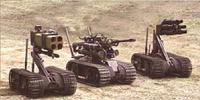-
U.S. Army creates a Cyber branch

Soldiers who want to defend the nation in cyberspace, as part of the U.S. Army’s newest and most technologically advanced career field, now have an Army branch to join that will take its place alongside infantry, artillery, and the other Army combat arms branches. Army Secretary John McHugh and Chief of Staff Gen. Raymond Odierno approved the creation of the Cyber branch in September. “The establishment of a Cyber Branch shows how important and critical the cyber mission is to our Army, and allows us to focus innovative recruiting, retention, leader development, and talent management needed to produce world-class cyberspace professionals,” said Lt. Gen. Edward Cardon, the commanding general of Army Cyber Command.
-
-
Navy considering allowing sailors temporary leave before returning to active duty

The U.S. Navy is considering allowing sailors to take temporary leave and return to active duty after earning degrees or working in the private sector. The plan would save the Navy money spent on training new sailors, while retaining experienced personnel for the long term.
-
-
Pentagon mulls “byte for a byte” cyber retaliatory operations
Much has been made of the phrase “an eye for an eye” throughout history, and it is beginning to appear that the oft-used motto will extend to the new fields of cyber warfare as well.This “approach is something our adversaries will readily understand,” one analyst writes. “If they escalate, we escalate. They know they will lose because we have far more cyber resources to draw on than they have, and we can cause real harm if they mess with us.”
-
-
ISIS has sufficient quantities of arms to carry on fighting for two years: UN

A new report prepared for the United Nations Security Council warns that Islamic State (ISIS) has in its possession sufficient reserves of small arms, ammunition, and vehicles to wage its war for Syria and Iraq for up to two years. The size and diversity the Islamist organization’s arsenal allow the group durable mobility, range, and a limited defense against low-flying aircraft. The report notes that even if the U.S.-led air campaign continues to destroy the group’s vehicles and heavier weapon systems, such a campaign “cannot mitigate the effect of the significant volume of light weapons” Isis possesses.
-
-
Transforming planes into flying aircraft carriers
Military air operations typically rely on large, manned, robust aircraft, but such missions put these expensive assets — and their pilots — at risk. While small unmanned aircraft systems (UAS) can reduce or eliminate such risks, they lack the speed, range, and endurance of larger aircraft. These complementary traits suggest potential benefits in a blended approach — one in which larger aircraft would carry, launch, and recover multiple small UAS. A flying carrier would allow the United States to use of drones in areas where the United States has no access to nearby airfields, but recovering a drone in mid-air remains a daunting technical challenge.
-
-
Wi-Fi signals enable through-wall detection
Engineers prove the concept that local Wi-Fi signals can be used to monitor moving objects and bodies that are otherwise visually obscured. Although fundamentally similar to traditional radar systems, their novel approach is entirely passive — utilizing the wireless signals that already swamp our urban airways. This technology has a wide range of applications from healthcare monitoring, security and emergency disaster relief, to finding earthquake survivors in fallen buildings.
-
-
Autonomous weapons which select, destroy targets without human intervention proliferate

More scientists are expressing concern over autonomous weapons which are able to select and destroy targets without human control or oversight. Armed drones can be operated by remote pilots, but weapons of the future will rely more on artificial intelligence to decide what to target and whom to kill.
-
-
New report urges policy overhaul, transparency in offensive cyber operations
A newly released report, titled Joint Publication 3-12(R) and authored by the Joint Chiefs of Staff, has revealed that some top commanders are calling for a policy overhaul and more public transparency in offensive cyber operations, given the growing need for such operations. Some previous documents have been published on the topic, but there is no official U.S. military policy book for cyber operations.
-
-
Boeing completes testing of new anti-jamming technology

Boeing says it has proven its new anti-jamming communications technology is capable of operating as either a ground-based user terminal or satellite-based networking hub, enabling the military to send and receive secure communications at a significantly lower cost by using existing terminals and satellites.
-
-
Legal framework needed to govern soon-to-arrive autonomous killer drones: Experts
With about 8,000 unmanned aircrafts and roughly 12,000 unmanned ground vehicles, the U.S. military boasts the world’s largest drone arsenal, followed by Israel, with China, Europe, India, and Russia in the second tier. Unmanned aerial vehicles (UAV) will pose a challenge to current international laws of warfare since someday, and sooner rather than later, they will be able to act autonomously – and kill autonomously. The international community has yet to adopt special laws to govern the use of drones in combat.
-
-
Students point to future of ocean robotics in new global game
College students from around the world demonstrated they could have a hand in shaping the future of ocean robotics as they competed in the first Maritime RobotX Challenge, which was held 24-26 October in Singapore. “Developing autonomy for surface vessels is still in its early stages, and these students have the opportunity to come up with solutions that could set new standards in this field,” said Assistant Chief of Naval Research Capt. Rob Palisin, who helped judge the competition. “In turn, the Navy gets the chance to observe the best young engineers in action and learn from their approaches.”
-
-
Egypt’s military involvement in the anti-Islamist campaign in Libya deepens
Two days ago, on Wednesday, Egypt has escalated its involvement in the battle against Libyan Islamists, as Egyptian warplanes conducted a series of attacks on Islamist militias’ positions in the eastern city of Benghazi. In late August, Egyptian and UAE warplanes attacked Islamist positions in and around Tripoli. Egypt’s growing direct military involvement in Libya has turned that country into yet another theater of a proxy war for broader regional battles, with Qatar and Turkey supporting the extremist Islamist militias while Egypt, Saudi Arabia, and the United Arab Emirates backing the militias’ opponents. The growing Egyptian involvement is an indication that after two years of introspection and confusion, the moderate forces in the Arab world have begun to assert themselves in an effort to gain a measure of control over post-Arab Spring developments in the region.
-
-
U.S. military must be ready for climate change: Hagel
Climate change is a threat multiplier, and the U.S. Defense Department is taking steps to incorporate this issue into all planning, Defense Secretary Chuck Hagel said in Peru Monday. Climate change has the potential to exacerbate many of the challenges the world already confronts, from the spread of infectious diseases to spurring armed conflicts, Hagel said at the Conference of the Defense Ministers of the Americas. Hagel announced a Defense Department Climate Change Adaptation Roadmap during his speech. The roadmap is based on science, he said, and describes the effects of climate change on DoD’s missions and responsibilities.
-
-
U.S. Navy unveils autonomous swarmboats to “swarm” hostile vessels
As autonomy and unmanned systems grow in importance for naval operations, officials at the Office of Naval Research (ONR) announced the other day a technological breakthrough that will allow any unmanned surface vehicle (USV) to not only protect Navy ships, but also, for the first time, autonomously “swarm” offensively on hostile vessels. The first-of-its-kind technology — successfully demonstrated over two weeks in August on the James River in Virginia — allows unmanned Navy vessels to overwhelm an adversary.
-
-
U.S. Cyber Command plans to recruit 6,000 cyber professionals, as U.S. mulls offensive cyber strategy
Last Wednesday, House Intelligence Committee Chairman Mike Rogers (R- Michigan) told reporters that he would like to see the United States adopt a more offensive strategy in cyberspace, but added that the Pentagon, intelligence agencies, and law enforcement must first develop protocols for offensive cyber measures.The following day, U.S. Cyber Command (USCYBERCOM) announced plans to recruit 6,000 cyber professionals and create 133 teams across the country to support the Pentagon in defending the nation’s cyber infrastructure.
-
More headlines
The long view
Tantalizing Method to Study Cyberdeterrence
By Trina West
Tantalus is unlike most war games because it is experimental instead of experiential — the immersive game differs by overlapping scientific rigor and quantitative assessment methods with the experimental sciences, and experimental war gaming provides insightful data for real-world cyberattacks.
Testing Cutting-Edge Counter-Drone Technology
Drones have many positive applications, bad actors can use them for nefarious purposes. Two recent field demonstrations brought government, academia, and industry together to evaluate innovative counter-unmanned aircraft systems.
European Arms Imports Nearly Double, U.S. and French Exports Rise, and Russian Exports Fall Sharply
States in Europe almost doubled their imports of major arms (+94 per cent) between 2014–18 and 2019–23. The United States increased its arms exports by 17 per cent between 2014–18 and 2019–23, while Russia’s arms exports halved. Russia was for the first time the third largest arms exporter, falling just behind France.
How Climate Change Will Affect Conflict and U.S. Military Operations
By Doug Irving
“People talk about climate change as a threat multiplier,” said Karen Sudkamp, an associate director of the Infrastructure, Immigration, and Security Operations Program within the RAND Homeland Security Research Division. “But at what point do we need to start talking about the threat multiplier actually becoming a significant threat all its own?”
The Tech Apocalypse Panic is Driven by AI Boosters, Military Tacticians, and Movies
By Matthew Guariglia
From popular films like a War Games or The Terminator to a U.S. State Department-commissioned report on the security risk of weaponized AI, there has been a tremendous amount of hand wringing and nervousness about how so-called artificial intelligence might end up destroying the world. There is one easy way to avoid a lot of this and prevent a self-inflicted doomsday: don’t give computers the capability to launch devastating weapons.
